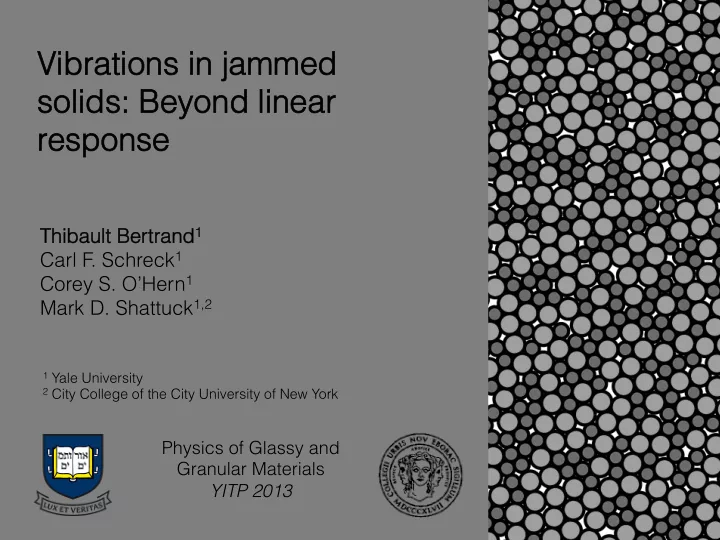

Vibrations in jammed ibrations in jammed solids: Beyond linear solids: Beyond linear response esponse trand 1 1 Thibault Bertrand Thibault Ber Carl F. Schreck 1 Corey S. O’Hern 1 Mark D. Shattuck 1,2 1 Yale University 2 City College of the City University of New York Physics of Glassy and Granular Materials YITP 2013
Nonlinear Effects in Granular Solids Nonlinear vibrational properties of granular solids – Vibration dampening, solitary modes, dispersion, deviations from elasticity theory Non-linear effects in real granular packings: • Breaking existing and forming new contacts • Non linear interactions (Hertzian) • Sliding and rolling friction • Energy dissipation Isolate the effects of fluctuations in the See Carl Schreck’s poster network of contacts! for details on Hertzian interactions
Absence of Linear Response Dynamical Matrix: ◆ 2 ✓ ✓ ◆ 1 − r ij 1 − r ij δ ∼ ∆ φ 1 / 2 V ( r ij ) = ✏ Θ 2 � ij � ij ✓ ∂ 2 V ◆ M ↵ , � = , ∂ r ↵ ∂ r � ~ r = ~ r 0 Diagonalize the dynamical matrix to access eigenfrequencies: 2 ✏ e i , i ∈ { 1 , . . . , 2 N } ˆ ✏ λ i = m ω 2 i
Absence of Linear Response Temperature allow particle to explore its ¡ δ surrounding on a distance δ : σ r 1 2 T 2 k δ 2 = T δ = k σ e ff = σ − δ Apparent diameter of a particle: ◆ 2 ✓ 1 − δ φ e ff = φ σ φ J Need to increase the volume fraction φ = ⌘ 2 to rejam the system at a given T: q ⇣ 2 T 1 − k σ 2
Absence of Linear Response φ J φ = ⌘ 2 q ⇣ 2 T ? 1 − k σ 2
Generating Jammed Packings
Beyond the Harmonic Approximation… • Molecular Dynamics Simulation • Constant energy • Linear Spring Repulsion • Frictionless • No dissipation • At t=0, add temperature N = 20
Non-harmonicity in Disordered Solids Pr Protocol: otocol: N ¡= ¡12 ¡ • Perturb along eigenmode by δ Δφ ¡= ¡10 -‑5 ¡ • Let the system evolve at constant energy mode ¡= ¡6 ¡ • Study the FT of the particle motion First ¡contact ¡breaks! ¡ Schreck, ¡Bertrand, ¡Sha.uck, ¡O’Hern, ¡Phys. ¡Rev. ¡Le+. ¡107 ¡(2011) ¡078301 ¡
Beyond the Harmonic Approximation… Under har harmonic appr monic approximation: oximation: M = k B T C − 1 V = 1 N h vv T i V = k B T I M = VC − 1 Solution 1: probing the correlation of particles Solution 1: displacements via Solution 2: Solution 2: looking for vibrational frequencies emerging in the Fourier Transform of the velocity autocorrelation function via P N i =1 h v i ( t ) . v i (0) i 0 d ( t ) = ˜ d ( ω ) = F [ d ( t )] P N i =1 h v i (0) . v i (0) i 0
(a) Assessing the Vibrational 0 10 Frequencies − 2 10 D ( ω ) − 4 10 − 6 10 (a) (b) 0 0.5 1 1.5 2 ω (b) 0 10 − 2 10 D ( ω ) − 4 10 − 6 10 0 0.5 1 1.5 2 ω
Assessing the Vibrational Frequencies 0 10 Non trivial evolution of the covariance matrix prediction and Fourier transform of Velocity autocorrelation − 2 function w/ T 10 D ( ω ) − 4 10 − 6 10 0 0.5 1 1.5 2 ω
Temperature Dependence of the Frequencies x ¡ k − ω d ω ∗ ω k ( T ) = ω d k k + ⌘ ν ⇣ √ 1 + l c ( ∆ φ ) / T
Temperature Dependence of the Frequencies x ¡
Testing Resonance in the Modes h K pp i • Drive one particle • Record average kinetic energy per particle in steady state N = 10 ∆ φ = 10 − 8
Rearrangement probability Packing did not did not rearrange earrange , relate to the same inherent structure Packing rearranged earranged , relate to a different inherent structure 100 snapshot over the course of the simulation
Introducing a new Phase Diagram z iso = dN − d + 1 ICS = Iso-coordinated Solid HCS = Hypo-coordinated Solid HPL = Hard Particle Liquid DL = Dense Liquid
Density of States ICS ¡ x ¡ HPL ¡ HCS ¡ x ¡ x ¡
Conclusions & Future directions • No linear response for a wide range of parameters • Need of a new description for the vibrational dynamics of jammed packings • Transition from resonant to non- resonant modes • Investigating effect of friction, particle shape and order “Vibrations in jammed solids: Beyond linear response”, T.Bertrand, C.F.Schreck, C.S.O’Hern and M.D.Shattuck, submitted to PRL (arXiv:1307.0440)
Acknowledgements • Corey O’Hern • Mark Shattuck • Carl Schreck Thank you! • The O’Hern Group • Yale High Performance Computing Grants: DTRA Grant No. 1-10-1-0021 NSF MRSEC DMR-1119826
Recommend
More recommend